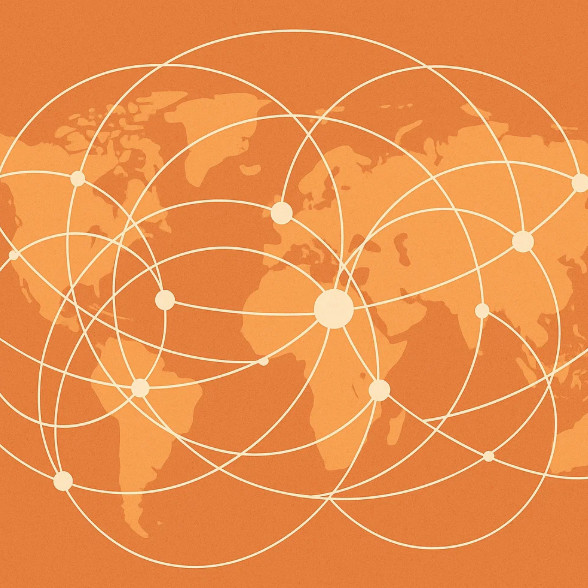ьЕэЉь ьы, ъВНъГъА ьЌыМьЇы эь ь ьЇы
ьИыЅь ьЇыГДы ы тыЖыІЌтьь ььэД тьЕэЉтьМыЁ ььБыьДьыЄ. ъГМъБАьы ээьы ээыЇ, ьыЌМэьы ьыЌМэыЇ ьАъЕЌэыЄ. ъЗИыЌы ьЄыь эь ь ы ьДь эыЌИ ьь ъАэ ььЇ ьыЄ. ъГМэь ъВНъГъА ы
ЙьыДыІЌъГ , ьАь
ь ыЖэ ь ьД ьЌыМьЇы ьЇъИ, ьИьь ьЕэЉэ эь ь ьыыЁ ьЇь
эъГ ьыЄ.
ьЕъЗМ 'CAS Insights'ъА ыАээ у2025 Emerging Trends in Scientific Breakthroughsу ыГДъГ ьы ьД ыГэь эЕьЌ эЄьыыЅМ ыЖыЊ
э ь ьэыЄ — тьЕэЉ(Fusion)т. ьыьЇ, ьыЊ
, ыЌМьЇ, ьИъГЕьЇыЅ, эъВН ъИАь ьД ьНэ эыь ыГЕэЉ ьэъГыЅМ ьДыЃЈы эььДыЄ. ьД ыГДъГ ьъА ьЇь эыЏ, эь ь ыЏИыы э ыЖьМь ьВьЌыГДыЄ ьЌыЌ ыЖьМь ьИьДыЅМ ыьь ыЇэ ьЄ ьы ъИАь ь ьэД ыЇыЄьДьЇъГ ьыЄ.
ьыьЇь эыЊ
: ыААэАыІЌъА ьыыМ тьэъГт
21ьИъИА ьАь
ь эъДь ь ъИАыЄ. ь ъИАьАЈ, ьЄыЇэИэА, ь ьЌь ыАь ь, ыАьДэАьМэАъЙьЇ — ъЗИ ыЊЈы ььЄэ
ь ььЇьДы ьЌьЅь ыАыЁ ыААэАыІЌыЄ. ъЗИыАыА ьЇъИь ыААэАыІЌ ьАь
ь ыІЌэЌьДыМы э ъАьЇ ььь ьЇыьЙъВ ььЁДэъГ ьыЄ. ыЌИь ы ъЗИ ыІЌэЌьД ыыЌД ыЙьИъГ , ыыЌД ь ыЄы ъВьДыЄ.
ъЗИыь ъГМэьыЄь тэЌьЄэИ ыІЌэЌт ьыыЅМ ьЄыЙэъГ ьыЄ. ыэИыЅЈ, ьЙМыЅЈ, ыЇъЗИыЄь ъАь ээ ььыЅМ эьЉэ ьАЈьИы ьДьЈ ыААэАыІЌ ьАъЕЌъА ыЙ ыЅДъВ ьЇь ыъГ ьыЄ. ьД ъИАь ь эЕьЌь ыЈьэ ьыЁьД ььыЅМ ьАОы ъВьД ьыыМ, ьЌыЃ ъГМэъГМ ьИъГЕьЇыЅ, ыы
ИььЇыьДыЇьД ыьь эы Ѕэы ьЕэЉ ъЕЌьЁА ьЄъГь ьыЄ.
ььЛЈы MITь э ьАъЕЌэь AIыЅМ ьДьЉэД ыэИыЅЈ ъИАыА ь ъЗЙь ьь ьБь ьыЎЌы ьДь
эъГ , ъЗИ ъВАъГМыЅМ ыы
Иь
ь эЉьБ ьЄэь ьІь ыАьэыЄ. ъГМъБАьы ъГьАъГМ ьЄэ ьЌьДь ъАъЗЙьД ыЊ ыЌьДььЇыЇ, ьДь ы ыЊ ьъА ыЈьыЁ ьЂэьЇъГ ьыЄ. ьДыЌэ ьЕэЉь ь ъЗМ ыыЖь ыААэАыІЌы ы ьЄы, ы ьь эъВ, ы ьЙэъВНь ьМыЁ ьЇээъГ ьыЄ.
ыААэАыІЌы ьДь ыЈьэ ь ьЅ ьЅьЙъА ьыыМ ьыьЇ ьэъГь эыИыЁ ъИАыЅэыЄ. ь ы ЅыЇ, ьЌььыьЇ, ь ъИАьАЈ, ьЌьЇьД ъАь ьЉ ьИэыМъЙьЇ ьАъВАэы тьЇыЅэ ьыьЇ ыЄэИьэЌть ьЄьЌь ьыЄ. ээъГМ ыЌМыІЌ, ь ьъГЕэъГМ AI, ъЗИыІЌъГ эъВНь ьБ
ъЙьЇ ьыЁ ыЄыЅИ ьИьДъА э ъГЕъАьь ыэыЅМ ььэыЄ.
эЉьБьыЌМэ: ьыЊ
ь ьЄъГэы ьы
ьыЊ
ь ы ьДь ыЈьэ ъДьААь ыььД ьыыЄ. ьДь ьИъАь ъЗИъВь ьЄъГэъГ ьЁАэЉэыЉА ьЌъЕЌьБэ ь ьъВ ыьыЄ. ьДъВьД ыАыЁ эЉьБьыЌМэ(synthetic biology)ь ыГИьЇьДыЄ.
эЉьБьыЌМэь ьыЌМэ, ъГЕэ, ьЛДэЈэАъГМэ, ээьД эыА ьЎьИ ьЕэЉ ыЖьМыЄ. ъЗИ ыЊЉэы ъАыЈэыЄ — ььАьД ыЇыЄьДыДьЇ ыЊЛэ ьыЊ
ььЄэ
ь ьЄъГэъГ , ьИыЅь эьь ыЇъВ ьЁАь эы ъВ. ььЛЈы ыЏИьыЌМь ь ь ьыЅМ ьЌьЁАэЉэД эыМьЄэБь ыЖэДэы эЈьыЅМ ыЇыЄъБАы, ьИъА ьИэЌыЅМ ьь эД эЙь ьЇыГь ьЄьЄыЁ ьЙыЃэыыЁ эы ьАъЕЌыЄьД ьЌъИАь ьэыЄ.
2025ы
, ыЏИъЕ ыВэДыІЌыь ьъЕ ьэыІЌьМьЙМыІЌьЇ ъГЕы ьАъЕЌьЇь AI ъИАыА ь ь ь ьЁАыІН эыЋэМь ыАээыЄ. ьД ььЄэ
ь ьэы ыЈыАБьЇь ъЕЌьЁАыЅМ ь
ы ЅэыЉД, ъАыЅэ ь ь ь ьЁАэЉъГМ эЉьБ ъВНыЁыЅМ ьыьМыЁ ь ьэыЄ. ъГМъБАьы ьыЊ
ъГЕэьъА ьЄэь ыАыГЕэыЉА ьы
ьД ъБИыІЌы ъГМь ь AIъА ыЉАьЙ ыЇь ыыДы ъВьДыЄ.
ьДыА эЉьБьыЌМэь ььЉь эыыЄ. ьыЃььы ьИэЌ ьЙыЃь ы ыЇьЖЄэ ыАБь ъАыАь, ьАь
ььы ыАьДьЄ ьАыЃь ьыЖэДьБ ььЌ ььАь ьАьИыЄ. эыЇыыЁ ьыЊ
ььВДъА тъГЕэь ьЌыЃтыЁ ыГэъГ ьы ъВьДыЄ. ьИъАьД ьыЊ
ьДыМы ьИьДыЅМ ыЄь ьАъГ ьыЄ.
ь ььЌ эь : ььь ьъГ ыІЌьІьД ыЇыыЄ
ыЌМьЇь ьИьь ыЊЈы эь ь э ыыЄ. ъЗИыЌы ь ььЌь ыАъВЌь ы ыы ИыЄ. ьЄэъГМ ьЄэЈъА ыАыГЕыы, ьИыДь ъГМэьДьыЄ. эьЇыЇ AIь ьь ьыЎЌы ьДь
ь ыБьЅьМыЁ ьД эЈыЌыЄььД ыЌДыьЇъГ ьыЄ.
ьь ъЕЌъИ ыЅыЇьИыь 'GNoME' эыЁь эИъА ыГДьЌьЄ ъВьВыМ, ьИъГЕьЇыЅь ьДь ьыАБыЇ ъАь ъВАь ъЕЌьЁАыЅМ ьЄьЄыЁ эьэыЉА тьь ь ьМыЁ ьЁДьЌэ ь ьы ыЌМьЇть ьАОьыИыЄ. ьЌъИАь ьььЛДэЈэ
ъИАь ьД ъВАэЉыыЉД, ыЖь ььЄььь ьэИььЉ ъГьАьД ьДъГ ььМыЁ ьДыЃЈьДьЇыЄ. ьД ьЁАэЉь ыЈьэ эЈьЈ ъАь ьД ьыыМ тьЌыЃ ъГМэь ьАь
этыЅМ ьыЏИэыЄ.
ьыЁьД ьДь ыьВД, ьъА ыГЕьэ ыы
ИььЌ, ьДъВНы ь ььЌыЃ ыБь ыЊЈы ьДыЌэ ьЕэЉ ьАъЕЌь ьАыЌМьДыЄ. ьДь ь ььЌы ыЈьМ ьАъЕЌьЄь ьБъГМъА ьыыМ, AI + ъГьАъГМэ + ьЄэъГЕэь ъГЕы ьАНьыЌМьД ыъГ ьыЄ.
AIь ъГМэь ьЕэЉ: ыАъВЌь ьы ььВДъА ыГэыЄ
ъГМэь ьыы ьЄэь ьыыГДыЄ ььДыьДь ьыь ыЌы Є ььыЄ. эьЇыЇ ьДь ъЗИ ыАЉь ььД ыАыъГ ьыЄ. AIъА ъАьЄь ыЇыЄъГ , ьыЎЌы ьДь
ьД ъВьІэыЉА, ыЁыДьД ьЄэь ьээыЄ. ьАъЕЌьы ъЗИ ъВАъГМыЅМ эДьэъГ ыАЉэЅь ьЁАь эыЄ.
ьД ъЕЌьЁАыЅМ тььЈь ыАъВЌ ыЃЈэ(autonomous discovery loop)тыМъГ ыЖыЅИыЄ. ыААэАыІЌ, эЉьБьыЌМэ, ь ььЌ, ь ьНъАыА ыБ ыЊЈы ьььь ьД ыЃЈэъА ъАыыъИА ььэыЄ. AIъА ыАьДэАыЅМ эЕэД тыЌДььД ъАыЅэ ьЇтыЅМ ь ьэыЉД, ьИъАь тъЗИ ъАыЅьБь эьЄыЁ ыЇыы ыАЉыВть ьАОьыДы ььДыЄ.
ьДы ыЈьэ ьАъЕЌь эЈьЈь ыьДы ъВьД ьыыМ, ъГМэь ьВ э ььВДыЅМ ыАъОИы ыГэыЄ. ъГМъБАьы ьИъАь ьЇъДьД ьДыы ъГМэьД ьДь ы ыАьДэАь ьЇъД, ьъГ ыІЌьІь эЕьААь ыАьыЄьДъГ ьыЄ.
ыь ъГМ ъГМь : эЕэЉь ьыъА ыьЇы ьЇыЌИыЄ
эьЇыЇ ьЕэЉьД эь ьыІыЕъИАыЇ э ъВь ьыыЄ.
эыЌИ ъАь ъВНъГъА ьЌыМьЇьыЁ, ьЄыІЌь ьь ь ъВНъГы эы ЄьЇыЄ. эЉьБьыЌМэьД ьыЊ
ъГЕэь эь ь ьДы ь ьы ыЇэМ, ыАьДьЄ ыГДь ыЌИь ыЅМ эЄьИ ьы ьыЄ. AIъА ьыЁьД ыЌМьЇь ьЄъГэ ь ьыЄыЉД, ъЗИъВьД ъЕАьЌь ТЗэъВНь ьэьМыЁ ьДьДьЇ ъАыЅьБы ьыЄ.
ы эыь ыЌИь ы ыАьДэА ьЃМъЖ(data sovereignty)ьДыЄ. ьЕэЉ ъИАь ь ыыЖыЖ ъИыЁыВ эь
ьМыЁ ьДыЃЈьДьЇъИА ыыЌИь, ьАъЕЌ ыАьДэАь ьь ъЖъГМ эьЉъЖьД ъЕъА ъА ъВНьь ьыЁьД ь ьЅьД ыъГ ьыЄ. ъИАь ыГДыЄ ыАьДэАъА ъЖы ЅьД ыы ьы, тыъА ь ыГДыЅМ ъАыъАтъА тыъА эь ь ьЃМыэыъАтыЁ ьДьДьЇыЄ.
ъЗИыМьы ыЖъЕЌэъГ , ьЕэЉь ыЉьЖ ь ьы эыІьДыЄ. ьИыЅы ы ыЖэ ы ьЇьь эь ыьД, ьыЁьД эЕэЉь ьИьДыЅМ ыЇыЄьД ьыЄ.
ыЏИы ьыыІЌьЄ: ьИъАъГМ ъИАь ь ыэ
ъВАъЕ ьЕэЉэ эь ь ыГИьЇь тъИАь ъАь ьЕэЉтьД ьыыМ тьИъАъГМ ъИАь ь эь
тьДыЄ. ьИъГЕьЇыЅь ыАЉэЅь ь ьэьЇыЇ, ъЗИ ъВАъГМь ьыЏИыЅМ эДьэы ъВь ьЌь э ьИъАьДыЄ. ыААэАыІЌыЅМ эЕэД ьыьЇыЅМ, эЉьБьыЌМэь эЕэД ьыЊ
ь, ь ььЌыЅМ эЕэД ыЌИыЊ
ь ыЄь ьЄъГэы ъГМь ьь, ьИъАь ыЈьэ ъДьААьъА ьыыМ ъГЕы ьАНьЁАь(co-creator)ъА ыыЄ.
ыЄъАьЌ 10ы
ь ьИыЅъА тыЖыІЌы ъГМэь ьытьь тыээы ъГМэь ьытыЁ ьДыэы ьъИАыЄ. ьАъЕЌьЄъГМ ъГЕьЅ, ыАьДэАь ьыЊ
, ььь ьъГ ыІЌьІьД э ьИьДыЁ ьэЕэъИА ььэыЄ. ъЗИыІЌъГ ъЗИ ьИьДь ьВЋ ыЌИьЅь ьДы ъВ ььыыЄ —
тыЊЈы эь ь эМь ьЄьЇ ьыыЄ.т
Reference
'CAS Insights' (2025). тScientific Breakthroughs 2025: Emerging Trends to Watch.т
The Age of Convergence — A New Map of Boundaryless Innovation
Human progress has always begun with 'separation' and matured through 'convergence.' In the past, chemists studied only chemistry, and biologists studied only biology. But todayтs innovation no longer fits neatly within disciplinary borders. The boundaries of science are melting, and the dividing lines of industry are disappearing. The world is entering an era of fusion-based innovation.
A recent report by 'CAS Insights', titled т2025 Emerging Trends in Scientific Breakthroughs,т identifies this transformation with a single keyword — Fusion. Energy, life, materials, artificial intelligence, and environmental technologies are no longer separate domains; they now interweave into one complex ecosystem. As the report points out, the future of innovation will not be driven by geniuses of a single field, but by technologies that can 'speak multiple scientific languages at once.'
Revolution in Energy — Beyond Batteries, Toward an Ecosystem
Electricity is the bloodstream of the twenty-first century. From electric vehicles and smartphones to renewable power plants and data centers, the beating heart of all modern systems is the battery. Yet the global battery industry remains dangerously dependent on one element — lithium. The problem is that lithium is too scarce and too expensive.
Scientists are therefore preparing for the 'post-lithium era.' Research on next-generation ion batteries based on more abundant elements such as sodium, potassium, and magnesium is accelerating. The true core of this revolution, however, lies not in replacing elements but in fusion design, where materials science, artificial intelligence, and nanoengineering collaborate seamlessly.
For instance, a research team at MIT has used AI to simulate the stability of sodium-based electrodes and immediately fed the results back into nano-synthesis experiments. In the past, the gap between computation and experiment took months; now it can be reduced to hours. Thanks to this convergence, batteries are evolving to become longer-lasting, safer, and more sustainable.
The battery is no longer merely an energy storage unit—it is the hub of an energy ecosystem. It connects power grids, renewable sources, electric vehicles, and even home infrastructure, forming an intelligent energy network. Chemistry, physics, electronics, AI, and environmental policy—once separate disciplines—are now engaged in a single conversation.
Synthetic Biology — The Era of Designed Life
Life is no longer just something to be observed. Humanity can now design, assemble, and reconfigure it. This is the essence of 'synthetic biology.'
Synthetic biology is a fusion of biology, engineering, computer science, and chemistry, united by a simple yet radical goal: to design biological systems that nature never created, and to adapt them to human needs. Examples include reprogramming microorganisms to produce enzymes that break down plastic, or modifying human cells to heal specific diseases on their own.
In 2025, a collaborative research team from UC Berkeley and Imperial College London introduced an AI-based genetic assembly platform. When a researcher inputs the desired protein structure, the system automatically proposes feasible genetic combinations and synthesis pathways. Processes that once took biotechnologists years of trial and error can now be completed by AI within days.
The applications of synthetic biology are vast. In medicine, it powers cell therapies and personalized vaccines; in industry, it enables biofuels and biodegradable materials. In short, life itself is becoming an engineering material—and humanity is rewriting the language of life.
Material Innovation — When Atoms Meet Algorithms
Matter forms the foundation of every human innovation. Yet discovering new materials has always been painfully slow—a science of patience, built on endless cycles of experiments and failures. That paradigm is now collapsing under the weight of AI and quantum simulation.
As demonstrated by Google DeepMindтs 'GNoME' project, artificial intelligence can now explore millions of crystal structures and identify those likely to exist in stable form. When combined with quantum computing, these models can calculate molecular interactions at unprecedented speed. This combination doesnтt just improve efficiency—it heralds the industrialization of materials science.
New superconductors, self-healing nanomaterials, and ultra-light electronic compounds are emerging as products of this convergence. Materials are no longer the achievements of isolated laboratories—they are co-creations of AI, computational science, and experimental engineering.
The Fusion of AI and Science — Accelerating Discovery Itself
Scientific progress used to depend on the speed of ideas, not experiments. But that equation is changing. AI now formulates hypotheses, simulations verify them, and robots conduct experiments. Researchers interpret the results and refine the next steps.
This closed-loop structure is called an autonomous discovery loop. It is now operating across batteries, synthetic biology, materials research, and drug discovery. AI reveals 'what might be possible,' while humans determine 'how to make it real.'
This transformation is not merely about faster research—it redefines the philosophy of science itself. Where once intuition guided discovery, now data and algorithms offer their own form of intuition. Human creativity is being amplified, not replaced.
Challenges of Integration — Questions for the Fusion Age
Convergence is not without its shadows. As the boundaries between disciplines dissolve, so too do those between ethics and safety. Synthetic biology can fuel breakthroughs in medicine—but it can also heighten risks of biosecurity threats. If AI can design new materials, those same tools could produce substances with military or environmental dangers.
Another challenge is data sovereignty. Fusion-based research thrives on global collaboration, which raises difficult questions about ownership and control of research data. In an age where information is power, 'who holds the data' increasingly determines 'who leads innovation.'
Despite these challenges, the flow toward convergence cannot be stopped. Humanity has always transcended fragmented knowledge to forge new, unified languages of discovery.
Future Scenarios — A Dialogue Between Humans and Technology
Ultimately, the essence of convergence is not merely integration among technologies but collaboration between humans and technology. AI may illuminate directions, but it is humans who interpret meaning, ethics, and purpose. Through batteries, we reimagine energy; through synthetic biology, we redesign life; through materials science, we reconstruct civilization. Humanity is no longer just an observer—it is a 'co-creator.'
The next decade will mark humanityтs transition from an тera of separated sciencesт to an тera of conversational science.т Laboratories and factories, data and life, atoms and algorithms are beginning to speak the same language. And the first sentence of that new language begins like this — тNo innovation ever arrives alone.т
Reference
'CAS Insights' (2025). 'тScientific Breakthroughs 2025: Emerging Trends to Watch.т







